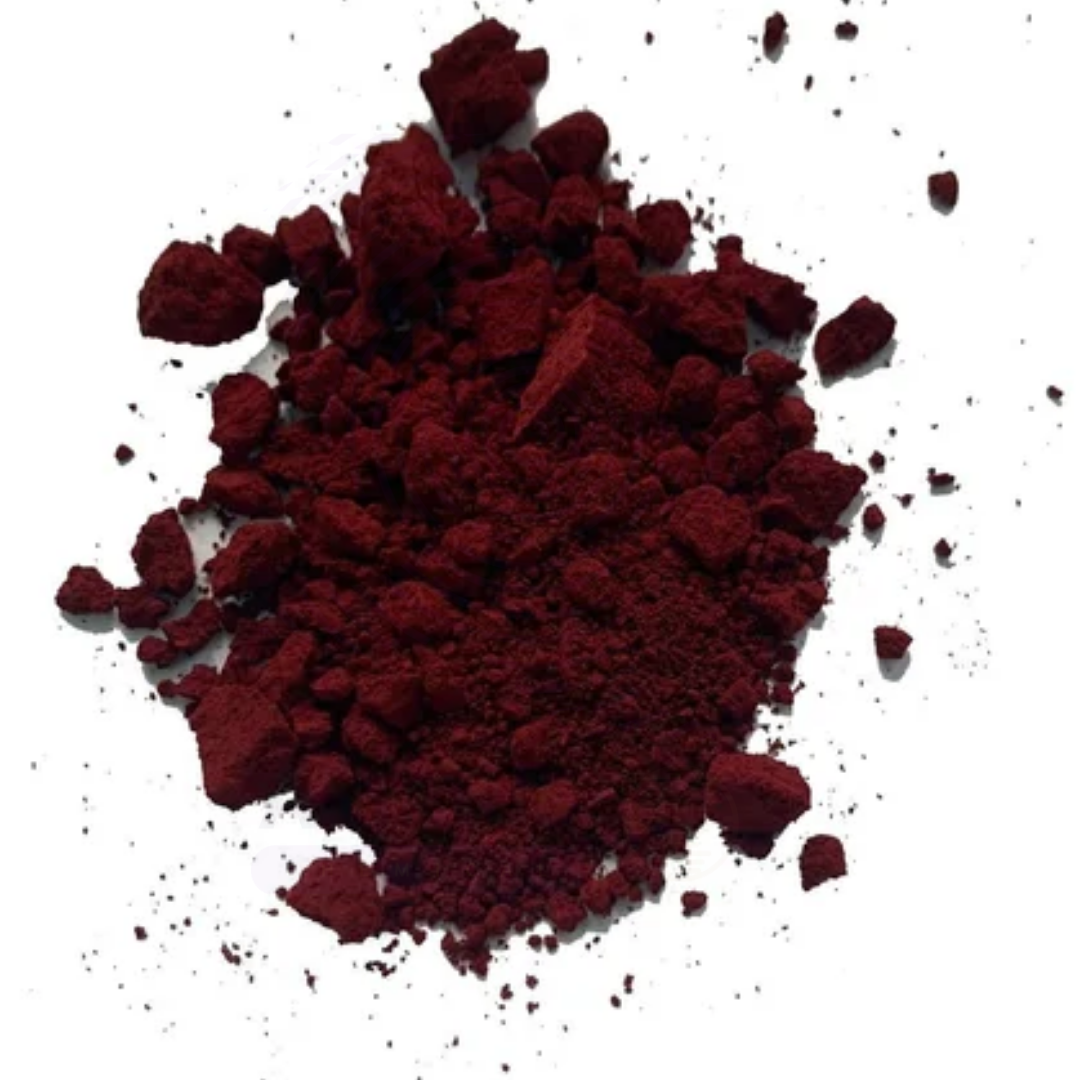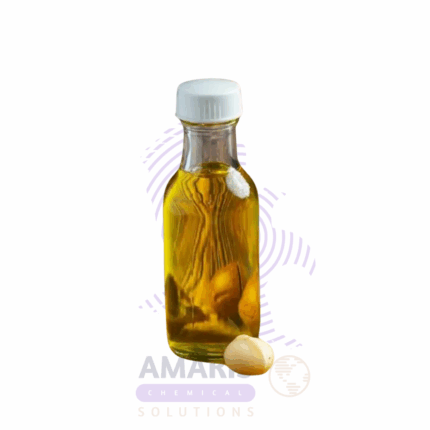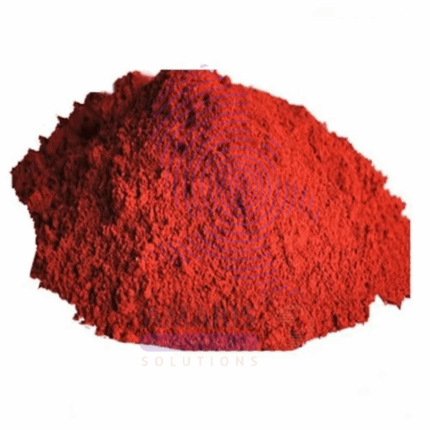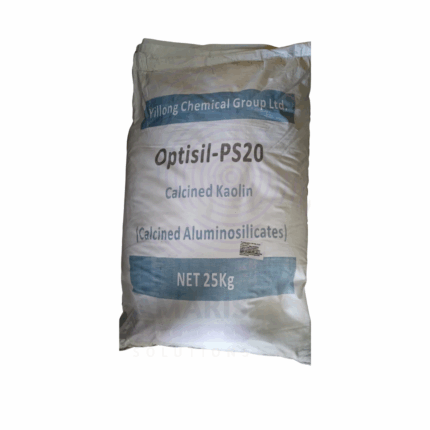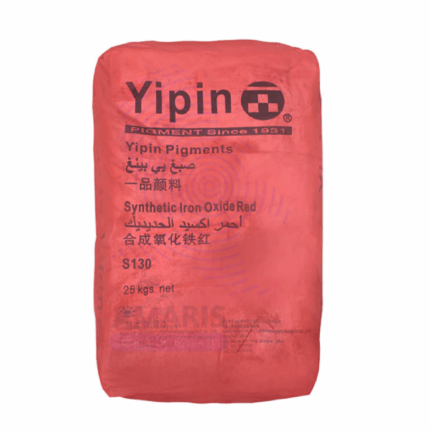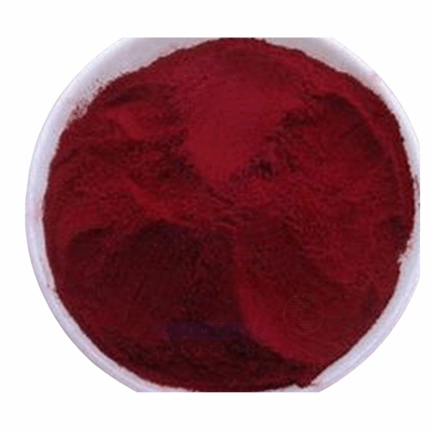Waxol Solvent Red 24
Whatsapp Order
Waxol Solvent Red 24 is a synthetic dye primarily used for coloring hydrocarbon-based products. It is a solvent-soluble red dye known for its excellent color strength, stability, and compatibility with various waxes, oils, plastics, and fuels. This dye is widely employed in industries requiring vibrant red coloration of non-polar materials, providing consistent performance under different processing conditions.
Description
Table of Contents
Toggle
Waxol Solvent Red 24
Primary Uses
- Fuel Industry
- Diesel and Gasoline Dyeing: Used to color fuels for identification, taxation, and quality control purposes.
- Lubricant Oils: Adds visual appeal and differentiation in lubricants and grease products.
- Wax & Paraffin Industry
- Colored Waxes: Used in paraffin wax, microcrystalline wax, and other wax blends for candles, crayons, and polishes.
- Cosmetic Waxes: Adds color to lipsticks, balms, and other wax-based cosmetic products.
- Plastics & Polymers
- Polymer Coloring: Incorporated into polyethylene, polypropylene, and other plastics for decorative and functional coloration.
- Masterbatches: Used in concentrate form for industrial color masterbatch production.
- Printing & Ink Industry
- Solvent-Based Inks: Utilized in printing inks that require solvent solubility and vibrant red color.
Secondary Uses
- Textile Industry
- Specialty Dyeing: Applied in limited cases for dyeing hydrophobic textile fibers and synthetic fabrics.
- Adhesives & Coatings
- Colorant: Used to impart color in solvent-based adhesives and coatings where water solubility is not desired.
- Research & Development
- Colorant Studies: Used as a standard dye in experiments requiring stable red coloration in non-polar matrices.
KEY PRODUCT FEATURES
1. Basic Identification Attributes
- Chemical Name (IUPAC): 1-(2,5-Dimethylphenylazo)-2-naphthol
- Common/Trade Name: Waxol Solvent Red 24
- CAS Number: 61969-48-2
- HS Code: 3204.17.00
- Synonyms: Solvent Red 24, Waxol Red 24, Sudan Red 24
2. Physical & Chemical Properties
- Physical State: Powder or granular solid
- Color & Odor: Bright red; slight characteristic odor
- Solubility: Soluble in hydrocarbon solvents, oils, and waxes; insoluble in water
- Melting Point: Approx. 150-160 °C
- Density: About 1.1 g/cm³
- Stability: Good light and heat stability in non-polar media
3. Safety & Hazard Attributes
- GHS Classification: May cause skin and eye irritation; avoid inhalation of dust
- Toxicity: Low acute toxicity; handle with care to avoid prolonged exposure
- Exposure Limits: No specific occupational exposure limits established
4. Storage & Handling Attributes
- Storage Conditions: Store in a cool, dry, well-ventilated area away from strong oxidizers and heat sources
- Container Type: Sealed bags or drums to prevent moisture ingress
- Shelf Life: 36 months under proper storage
- Handling Precautions: Avoid dust formation and inhalation; use PPE during handling
5. Regulatory & Compliance Attributes
- Complies with: Relevant international dye and chemical safety regulations
- Manufactured under: GMP and ISO standards ensuring consistent quality
- Use Restrictions: Not intended for food or pharmaceutical applications unless specifically certified
6. Environmental & Health Impact
- Biodegradability: Not readily biodegradable due to synthetic azo structure
- Ecotoxicity: May pose risks to aquatic life if released untreated
- Bioaccumulation: Limited data; avoid environmental release
SAFETY HANDLING PRECAUTIONS
Safety Handling Precautions
- PPE Required: Gloves, safety glasses, dust mask or respirator if airborne dust is present
- Handling Guidelines: Use local exhaust ventilation and avoid generating dust
- Storage Measures: Keep container tightly closed and dry
First Aid Measures
- Inhalation: Move to fresh air and seek medical advice if symptoms persist
- Skin Contact: Wash affected area with soap and water
- Eye Contact: Rinse thoroughly with water for at least 15 minutes; seek medical attention if irritation continues
- Ingestion: Do not induce vomiting; seek medical advice immediately
Firefighting Measures
- Fire Hazards: Combustible solid; dust may form explosive mixtures in air
- Extinguishing Media: Use dry chemical, foam, or CO₂
- Hazardous Combustion Products: Carbon oxides, nitrogen oxides, and potentially toxic azo compounds
Related products
Bright Red Dye
Bright Red Dye is a high-strength, water-soluble synthetic dye solution designed for vibrant red coloration across various industrial and consumer products. With 20% active dye content, it offers excellent color intensity, easy dispersibility, and compatibility with a wide range of aqueous systems. This versatile dye is widely used in textiles, paper, personal care products, and household cleaning formulations.
Calcined Kaolin
$ 1.20
Calcined Kaolin is a fine, white to off-white powder produced by heating natural kaolin clay to high temperatures (typically between 600°C and 900°C) in a controlled process called calcination. This thermal treatment removes chemically bound water, changes the crystalline structure, and enhances the physical and chemical properties of kaolin. The resulting product exhibits increased brightness, hardness, and opacity, making it highly valuable as a functional additive and filler in numerous industrial applications. Calcined Kaolin is widely used in coatings, ceramics, plastics, rubber, paper, and paint industries to improve durability, brightness, and performance.
PIGMENT ORANGE 20%
Product Description
Pigment Orange 20% is a concentrated dispersion of synthetic orange pigment particles in a suitable carrier, designed to deliver bright, vivid orange coloration. It offers excellent stability, heat resistance, and chemical inertness, making it suitable for diverse industrial applications including paints, plastics, inks, and coatings. This pigment ensures consistent color strength and durability across a variety of substrates.
Red Oxide S130
Red Oxide S130 is a high-purity synthetic iron oxide pigment that offers a deep red hue with excellent opacity, dispersibility, and weather resistance. It is widely used in the coatings, construction, plastics, rubber, ceramic, and ink industries for its color stability, non-toxicity, and resistance to UV light and chemicals. Red Oxide S130 is finely milled for consistent performance and is suitable for both indoor and outdoor applications. Its chemical inertness and thermal stability make it ideal for demanding environments requiring long-lasting coloration.
Scarlet Chrome
Scarlet Chrome is a vibrant, high-quality inorganic pigment primarily composed of lead chromate compounds. Known for its brilliant scarlet-red hue, it offers excellent opacity, weather resistance, and durability. Scarlet Chrome pigment is widely used in paints, coatings, plastics, and printing inks where strong, long-lasting color performance is essential. Its chemical stability and resistance to light and heat make it a preferred choice for outdoor applications and industrial finishes.
Solvent oil red 24 OSH
Solvent Oil Red 24 OSH is a bright, oil-soluble azo dye used primarily for coloring petroleum-based solvents, oils, waxes, and greases. Known for its excellent solubility in hydrocarbon mediums, this dye delivers a vivid red hue with good thermal stability and moderate lightfastness. Its OSH (Oil Soluble High) formulation ensures optimized dispersion in non-polar systems.
Solvent Oil Red 24 OSH is used in applications requiring visual identification, fuel marking, and product differentiation across industrial environments. It is available in powdered or granulated form and is manufactured to meet industrial-grade quality standards.
Strawberry Red Pigment
Strawberry red pigment is a concentrated synthetic pigment dispersion providing a bright and vivid strawberry-red coloration. Known for its excellent lightfastness, chemical resistance, and thermal stability, it is widely used in paints, coatings, plastics, inks, and specialty industrial applications. The pigment ensures consistent color strength and durability across multiple manufacturing processes and substrates.
Whiting
Whiting is a finely ground, white, chalky substance primarily composed of calcium carbonate (CaCO₃). It is widely used as a pigment, filler, and extender in various industrial and commercial applications. Whiting provides opacity, brightness, and smoothness to products, enhancing their appearance and physical properties. Its natural abundance and versatility make it an economical additive in multiple manufacturing processes.


 Preservatives(food)
Preservatives(food) Flavor Enhancers
Flavor Enhancers Acidulants
Acidulants Sweeteners
Sweeteners Antioxidants
Antioxidants Colorants(food)
Colorants(food) Nutraceutical Ingredients (food)
Nutraceutical Ingredients (food) Nutrient Supplements
Nutrient Supplements Emulsifiers
Emulsifiers
 Collectors
Collectors Dust Suppressants
Dust Suppressants Explosives and Blasting Agents
Explosives and Blasting Agents Flocculants and Coagulants
Flocculants and Coagulants Frothers
Frothers Leaching Agents
Leaching Agents pH Modifiers
pH Modifiers Precious Metal Extraction Agents
Precious Metal Extraction Agents
 Antioxidants(plastic)
Antioxidants(plastic) Colorants (Pigments, Dyes)
Colorants (Pigments, Dyes) Fillers and Reinforcements
Fillers and Reinforcements Flame Retardants
Flame Retardants Monomers
Monomers Plasticizers
Plasticizers Polymerization Initiators
Polymerization Initiators Stabilizers (UV, Heat)
Stabilizers (UV, Heat)
 Antifoaming Agents
Antifoaming Agents Chelating Agents
Chelating Agents Coagulants and Flocculants
Coagulants and Flocculants Corrosion Inhibitors
Corrosion Inhibitors Disinfectants and Biocides
Disinfectants and Biocides Oxidizing Agents
Oxidizing Agents pH Adjusters
pH Adjusters Scale Inhibitors( water)
Scale Inhibitors( water)
 Antioxidants(cosmetic)
Antioxidants(cosmetic) Emollients
Emollients Fragrances and Essential Oils
Fragrances and Essential Oils Humectants
Humectants Preservatives
Preservatives Surfactants(cosmetic)
Surfactants(cosmetic) Thickeners
Thickeners UV Filters
UV Filters
 Fertilizers
Fertilizers Soil Conditioners
Soil Conditioners Plant Growth Regulators
Plant Growth Regulators Animal Feed Additives
Animal Feed Additives Biostimulants
Biostimulants Pesticides (Herbicides, Insecticides, Fungicides)
Pesticides (Herbicides, Insecticides, Fungicides)
 Active Pharmaceutical Ingredients (APIs)
Active Pharmaceutical Ingredients (APIs) Excipients
Excipients Solvents(pharmaceutical)
Solvents(pharmaceutical) Antibiotics
Antibiotics Antiseptics and Disinfectants
Antiseptics and Disinfectants Vaccine Adjuvants
Vaccine Adjuvants Nutraceutical Ingredients (pharmaceutical)
Nutraceutical Ingredients (pharmaceutical) Analgesics & Antipyretics
Analgesics & Antipyretics
 Analytical Reagents
Analytical Reagents Solvents(lab)
Solvents(lab) Chromatography Chemicals
Chromatography Chemicals Spectroscopy Reagents
Spectroscopy Reagents microbiology-and-cell-culture-reagents
microbiology-and-cell-culture-reagents Molecular Biology Reagents
Molecular Biology Reagents Biochemical Reagents
Biochemical Reagents Inorganic and Organic Standards
Inorganic and Organic Standards Laboratory Safety Chemicals
Laboratory Safety Chemicals Specialty Laboratory Chemicals(Special Laboratory Equipment)
Specialty Laboratory Chemicals(Special Laboratory Equipment)
 Demulsifiers
Demulsifiers Hydraulic Fracturing Fluids
Hydraulic Fracturing Fluids Scale Inhibitors(oil)
Scale Inhibitors(oil) Surfactants(oil)
Surfactants(oil) Drilling Fluids
Drilling Fluids
 Dyes and Pigments
Dyes and Pigments Bleaching Agents
Bleaching Agents Softening Agents
Softening Agents Finishing Agents
Finishing Agents Antistatic Agents
Antistatic Agents
 Admixtures
Admixtures Waterproofing Agents
Waterproofing Agents Sealants and Adhesives
Sealants and Adhesives Curing Compounds
Curing Compounds Concrete Repair Chemicals
Concrete Repair Chemicals Anti-Corrosion Coatings
Anti-Corrosion Coatings
 Surfactants(cleaning)
Surfactants(cleaning) Builders
Builders Enzymes
Enzymes Solvents (Cleaning)
Solvents (Cleaning) Fragrances
Fragrances
 Electronic Chemicals
Electronic Chemicals Catalysts
Catalysts Lubricants
Lubricants Photographic Chemicals
Photographic Chemicals Refrigerants
Refrigerants Automotive chemicals
Automotive chemicals Pyrotechnic Chemicals
Pyrotechnic Chemicals
 Biodegradable Surfactants
Biodegradable Surfactants Bio-based Solvents
Bio-based Solvents Renewable Polymers
Renewable Polymers Carbon Capture Chemicals
Carbon Capture Chemicals Wastewater Treatment Chemicals
Wastewater Treatment Chemicals
 Pigments
Pigments Solvents(paint)
Solvents(paint) Specialty Coatings
Specialty Coatings Binders/Resins
Binders/Resins Additives
Additives Driers
Driers Anti-Corrosion Agents
Anti-Corrosion Agents Functional Coatings
Functional Coatings Application-Specific Coatings
Application-Specific Coatings
 Fresh Herbs
Fresh Herbs Ground Spices
Ground Spices Whole Spices
Whole Spices Spice Blends
Spice Blends Dried Herbs
Dried Herbs
 Leavening Agents
Leavening Agents Dough Conditioners
Dough Conditioners Flour Treatments
Flour Treatments Fat Replacers
Fat Replacers Decoratives
Decoratives Preservatives(baking)
Preservatives(baking)
 Plasticizers & Softeners
Plasticizers & Softeners Reinforcing Agents
Reinforcing Agents Adhesion Promoters
Adhesion Promoters Vulcanizing Agents
Vulcanizing Agents Antidegradants
Antidegradants Blowing Agents
Blowing Agents Fillers & Extenders
Fillers & Extenders Accelerators & Retarders
Accelerators & Retarders